
Paula Boadas and Jessica Raya are the alma mater of SSIC and Paul, a fashion-house founded in 2012 which combines creativity with functionality via garments with a Nordic inspiration which nonetheless do not lose their Mediterranean essence. The brand goes for a rational design along minimalist lines in which priority is given to shapes and materials, all under the label “made in Barcelona”, for workmanship and locally-based production in a company which opts for discreet luxury.

Do you recall how the project started ?
Paula: Yes, of course ! – she smiles – It was in our days as design students in Felicidad Duce. We met there, got on well and started to create a joint project.
Jessica: the truth is that we had a pretty good idea that we wanted to focus on this and to establish a brand.
SSIC and Paul is in fact an abbreviation of your two names…
Paula: Exactly ! It’s difficult to remember the name of the brand, but they are our abbreviated initials. We don’t complicate things by searching for other ones !

What do each of you bring to the brand ? How do you structure things ?
Jessica: In reality the two of us do everything and we complement each other with regard to ideas for the collections. Basically it is practical that there are two of us because we can give each other ideas.
Paula: The truth is that the key to our success is that right from the start we have also had this empathy and this commonality. We’ve been together 10 years, 5 of which are as a brand, which is no small thing. Now we have more business acumen we share the design tasks and then we divide up the work to produce it all.
“ It’s practical that there are two of us because we can give each other ideas !
What I specifically wanted to ask you both is when did you change your approach to give your company a more business-oriented slant ?
Paula : To be specific it was the moment we realised that it wasn’t a game and that we wanted to dedicate ourselves to it. We tailor our products to price and we always adapt to the market.
Jessica: Yes, when you start to run shops you come to see what people like, what sells and what doesn’t sell.

How do you find the happy medium between the commercial and the creative ?
Paula: Obviously you have to have your feet on the ground, but without sacrificing design, quality or creativity. The only thing we do is to make some garments more commercial and others more conceptual.
Jessica: Without doubt that is the most difficult part, because you have to develop your own identity but also take into account that what you create is saleable.
So in your case the identity is Northern soul and Mediterranean essence ?
Jessica: Yes, we have a minimalist, more contemporary style, more in keeping with northern design, but we adapt it to our soociety. We like our brand to be linked with the northern soul of the Mediterranean.
Paula: We also consider ourselves a brand “made in Barcelona” because we make everything in our workshops here.

“You have to have your feet on the ground, but without sacrificing design or creativity”
Two years ago you opened your own shop in the Sant Gervasi district. How many other business outlets do you have ?
Paula: Yes, and now we have 15 multi-brand sales points throught Spain and we are growing on the international front.
In which countries ?
Jessica: Italy, Belgium, USA and now Mexico. It also depends on the collection.

What is your link with Gratacós ?
We’ve always seen the shop as a point of reference in Barcelona. We especially adore it because in addition to the quality they also sell different fabrics which offer a little bit more than what already exists in the market.
Paula: Yes, above all the quality, which is noted in the fabrics and the textures. In Gratacós we like to buy the fabrics for holiday collections, they are dazzlingly spectacular.
“Gratacós sells fabrics which are different from what already exists in the market “
What challenges are you giving yourselves for 2017 ?
Paula: Global international expansion. Now we are concentrating on trade-fairs in order to acquire more international customers. We are looking outwards.

Gratacós Questionnaire
Your “must have” garment… tunic
A fetish fabric…silk
The colour you won’t give up… ivory
An infallible style rule… Cloaks and overlays
Favourite place in Barcelona…Gratacós
Advice for starters…Keep going
Your “leitmotif”… Northern soul from the Mediterranean






One to one with… Ángel Vilda
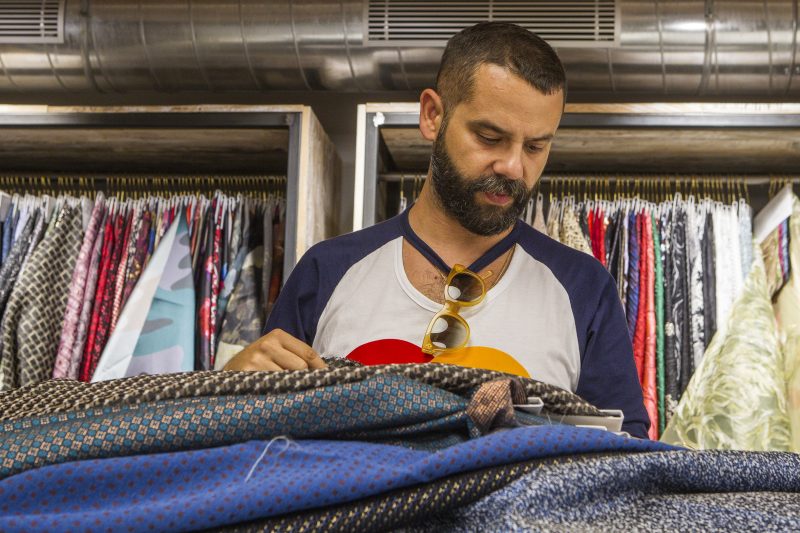
Dry, transgressor and visceral. Since 2010, Ángel Vilda channels his irony in Brain & Beast, his alter ego in design. An original band that is full of attitude, impossible combinations and high dosis of boldness. Garments that create visual games, structured lines, loud colours and iconography that feeds from contemporary culture with high dosis of humour. If it is kitsch, all the better. This Barcelona born designer came to visit us to buy fabrics for his new collection that he will be presenting in January in the 080 Barcelona Fashion catwalk. We took the chance to pick his brains…
What have you got prepared for the new Winter 2017 collection? What fabrics have you chosen?
This time, I have chosen the newest and oldest fabrics that Gratacós has on offer. The majority of the fabrics have been selected based on colours and prints because the collection is inspired in the ‘Play Back’ concept and fashion at the end of the 70’s. I want to do a representation of what it should be, but isn’t. A sort of virtual reality.
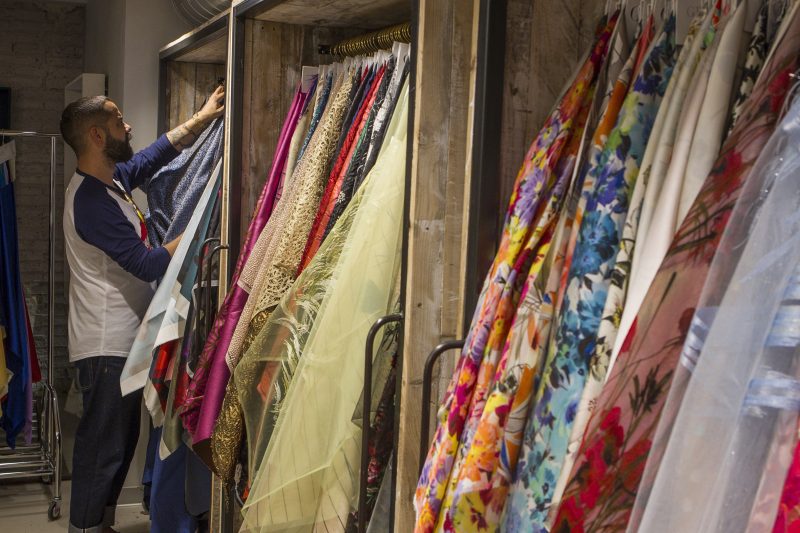
“I have chose the newest and oldest fabrics Gratacós has on offer”
What patterns do you have in mind?
An absolute mix. From traditional Japanese patterns, patterns for traditional clothes, pyjama type garments with dressing gowns you would wear at home, sport clothes….All together and with no direction. One of the basic premises of my new collection is it will be like that just because.
It’s very Brain & Beast…
Always! This proposal is also inspired in icons of the time such as the singer Nico in ‘The Velvet Underground’, films such as `The Invisible Man`, the beginnings of David Lynch…There will be dreamlike references where you will not know if it is a dream or a nightmare. The novelty of this collection is that it will not be produced on an industrial level.
Why not?
Because as from now I have decided to work only on demand and I will not sell to shops or retails points any longer.
Why this change in direction?
I want to dedicate more time to each garment so that it is unique and special. Everything will be handmade: prints, embroidery….all because I want the client to notice the handicraft work gone into their custom made garment.
“I want to dedicate more time in looking after each garment so that it is unique”
Exclusivity, customization….the marketing trends are going in this direction
But in this case I have taken this decision because I feel like doing it, I’m looking forward to it.
How do you evaluate this stage being on your own as the only designer of the brand?
Very well. Brain & Beast is selling more than ever. The brand started out as a get together with friends where we had fun designing, but with time we each have developed our own interests and now it is different.
¿How do you define yourself as a designer?
As a designer and that’s it. I don’t like it when designers consider themselves to be something important like a doctor or scientist. We make clothes and that’s it, if someone does not like it, then they don’t have to buy it. Easy as that.
“We make clothes and that’s it. If someone does not like it then they don’t have to buy it”
It is a question of not glorifying the creative work….
Exactly. I also find it funny when people call themselves creative director instead of designer. Lately there are new words for everything. It’s not even a big deal because if you analyse the scenario in Spain I don’t think there are designer brands powerful enough on an international level. We are a collage of mini brands. Brain & Beast is aware of its limitations and to be honest, I don’t care.
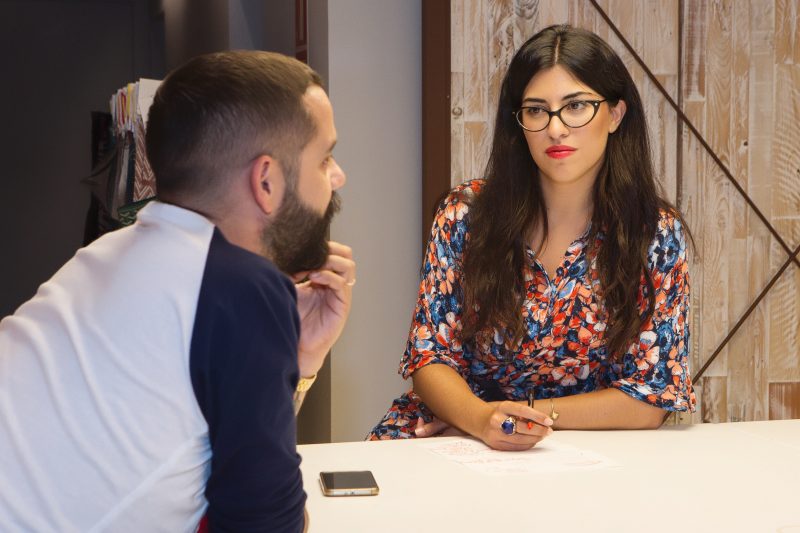
Are you sure?
I am pleased that Brain & Beast is a tiny part of the sector. My inspiration is to wake up in the morning and do what I like and make a living out of it. I crack up when I see brands that boast about selling in Japan when it is very easy to sell there. If you can’t sell in that country it means you are not very good. In any case, what I mean is that in the industry of fashion there is a lot of facades. I also find it funny these reports about promising young design talents. No-one will ever get anywhere.
“I am pleased that Brain & Beast is a tiny part of the sector”
A very pessimistic point of view….
Not at all. In Spain there isn’t a market for design, there are no retail points to commercialize, the multibrand shops are closing and being replaced by cheap chain stores… Either you spring into action or go to another country.
A few years ago, the guru Diane Pernet visited Barcelona and was fascinated by your designs. How did you do it?
I think the key is to be a pest- he laughs- and it is also true that I have been in the design world for a long time. Independently of whether there is talent or not, I think perseverance is the key. Another key aspect of Brain & Beast is that it is a 100% independent brand. No-one has never paid us anything, no help, no sponsors, no capitalist shareholders…When we have been successful in a collection we have bought the fabrics in Gratacós and when not, we have been to the Encants market and no quarms.
The Gratacós questionnaire…
An essential garment… Something that you can take off easily
A fetiche fabric… A multicolour brocade
A colour you could not live without… Red
A designer you admire… Brain & Beast
Your preferred space in Barcelona… My house
A word of advice for those starting out… Get a grip
Your ‘leitmotiv’…Everything is shit but once you have accepted it, that’s it.
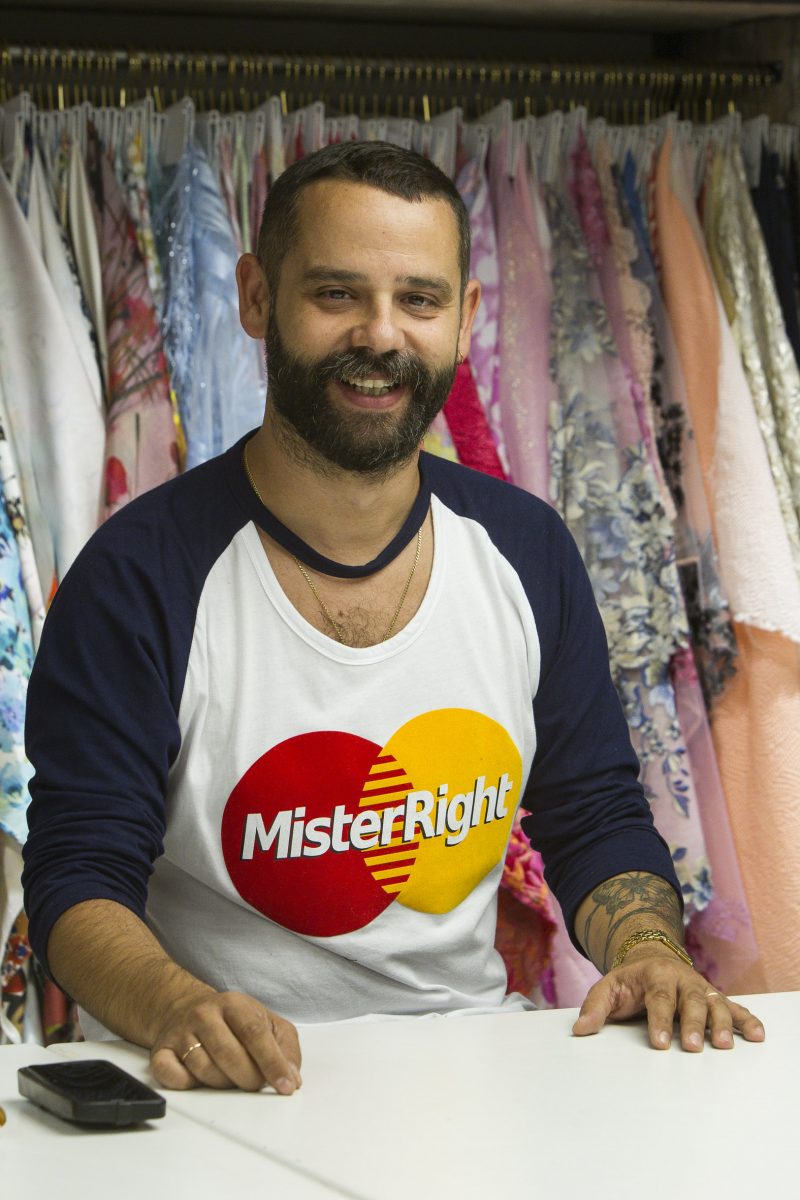
One to one with… José María García from Ze García
José María García has spent the last 4 years in charge of his female fashion brand, designing dresses and suits for special occasions in his workshop in Barcelona. Ze Garcia is synonymous of affordable haute couture for the modern, sensual and elegant woman. Each and every garment is made to measure, taking into account the style, personality and silhouette of the customer. Ze Garcia must have something special considering all the fashion instagrammers follow him. Including Dulceida who has confided her trust in the young Catalan designer and given him the task of designing her wedding dress. An online phenomenon that has caused a lot of sensation. Beyond this passing boom, Jose María García presses forward with his work at a steady pace and with very clear ideas…
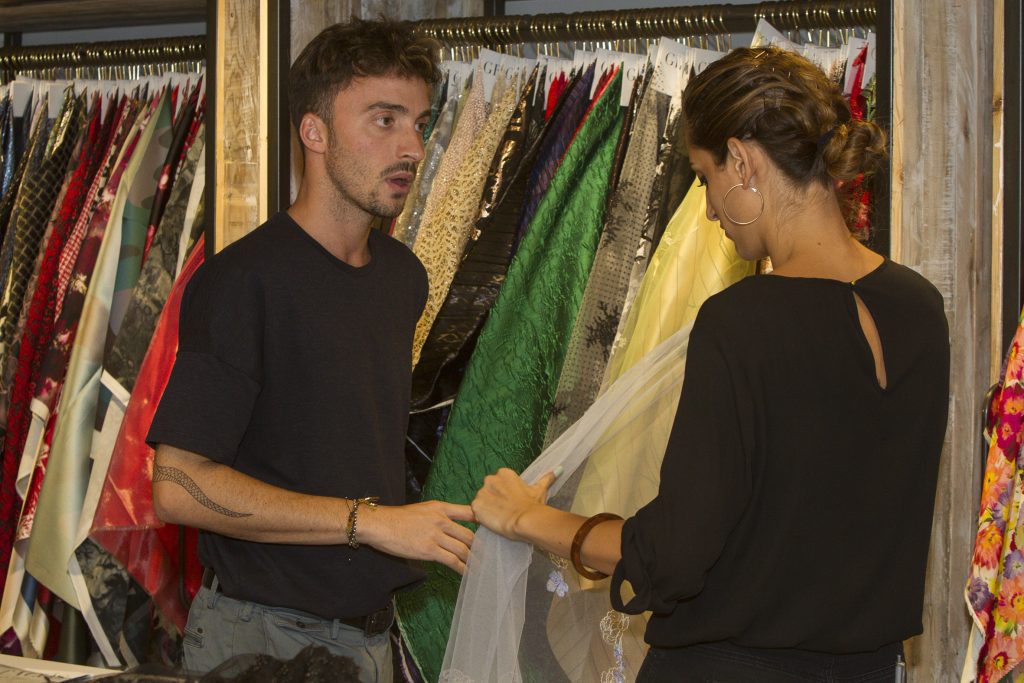
Did you expect to be a dying sensation with the wedding designs for Dulceida? The social networks are still raving on about it….
These past few days have been crazy and we did not expect this media coverage. The number of my followers has increased drastically. I’d already worked with Dulceida in the past with other designs for different events she had attended, but it is true that the wedding has been a complete boom.
The big wedding brands such as Pronovias or Rosa Clará were chasing after the famous dress…
I know, I know. However, Aida and I are friends and she has always trusted me; both as a designer and as a friend. I have been working with her for many years and I know her tastes and her measurements and I know I won’t let her down. It was a great pleasure for me to be given the the responsability of designing her two wedding dresses and also her girlfriend Albas´. This has allowed me to do three styles: one princess style dress with 40 metres of tulle, another more bohemian one like what is in fashion now and the third a tailored suit with a V-neck body which is what Im most used to doing.
«Dulceida has given me the responsability of designing her wedding dresses»
This has allowed you to experiment with a variety of styles….
Exactly! For me, the most important part of this experience has been that I have not been pigeon-holed into one concrete style, but I’ve been able to adapt the style to each girl.
With so many admirers, have the complements or criticisms affected you?
Its been fine, because my main worry was if the dresses were made up correctly at a technical level and also the brides’ expectations. Obviously everyone has different tastes so there will be people who like them alot and others who do not.
The fabric for the wedding dresses was bought from Gratacós, but its true that you often confide in us…
I’ve confided in you for a long time now. The quality of fabrics in your shop is the best. It is true that I vary where I buy my fabrics from, but you have always been a reference for me. When you need a “top” fabric, you can find it in Gratacós.
«When you need a “top” fabric, you can find it in Gratacós»
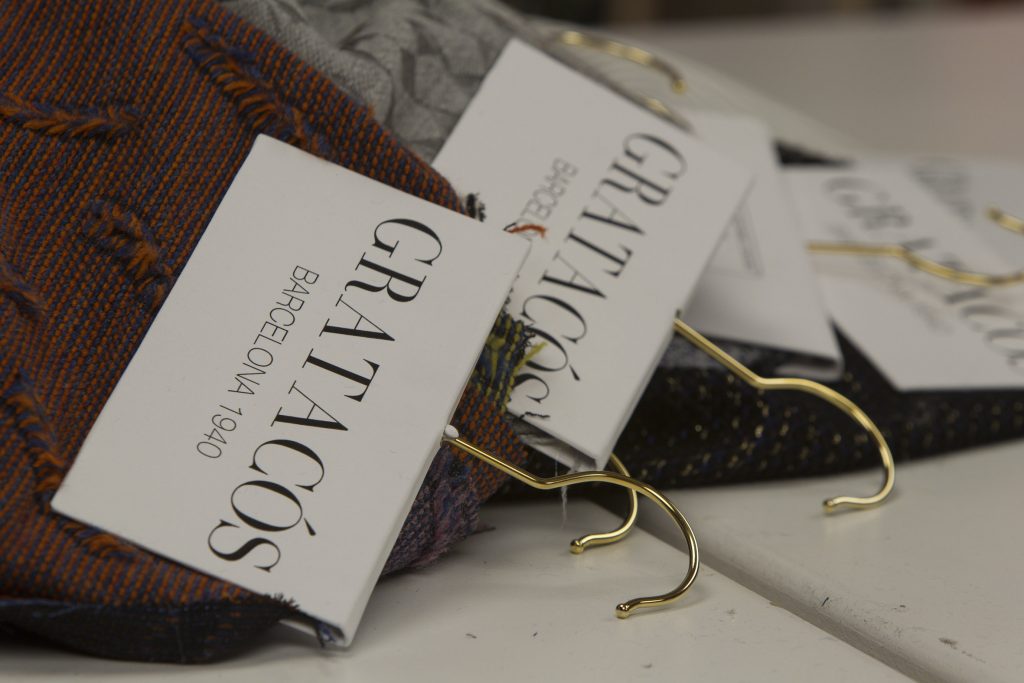
How did you start out in the design world? You mentioned that you were born with it in your blood….
I always wanted to be a designer and I was sure of this ever since I was little. I started sewing classes at 12 and I later realized I needed to learn the trade so I began studing at the Technical Art Fashion School in the Ramon LLul University in Barcelona. When I finished my studies, I began working for Emporio Armani in charge of visual image – shop window displays and styles. After working with several brands, I decided to begin my own.
How do you differentiate yourself from your competition?
The designers approach, personal taste and the things you bet on are important. Every brand has its creators signature and in ZE García its me myself.
What do you offer your customer?
I always attend to them. In fact, I always do this; I assist more than I design. Nowadays it is more important to know how to sell than what to sell.
«Its more important to assist than design»
How do you work in Ze García?
Always upon request. The customer comes to our showroom in C/Tuset and there they can take a look at our best selling garments that are on show. These are generally single garments rather than made up dresses, because the type of customer who comes to us has many events, so what we aim to do as a brand is that from one dress we can do various options.
What type of customers do you have?
A typical customer is a young attractive girl from 20 to 35 years old. Im really lucky!- he says smiling.
Which other celebrities have worn your designs?
The majority of fashion instagrammers such as Belén Hostalet or Inés Arroyo and actresses such as
Thaïs Blume who came here to Gratacós. Im quite selective when it comes to actresses and I always decide who I want to wear my designs.
What challenges lay ahead for the upcoming years?
At the moment, stay as I am at a sure and steady pace. My brand has been running for 4 years (he is now 28 years old) and I want to mature as a designer with it. I enjoy everything a lot more if things just happen without planning.
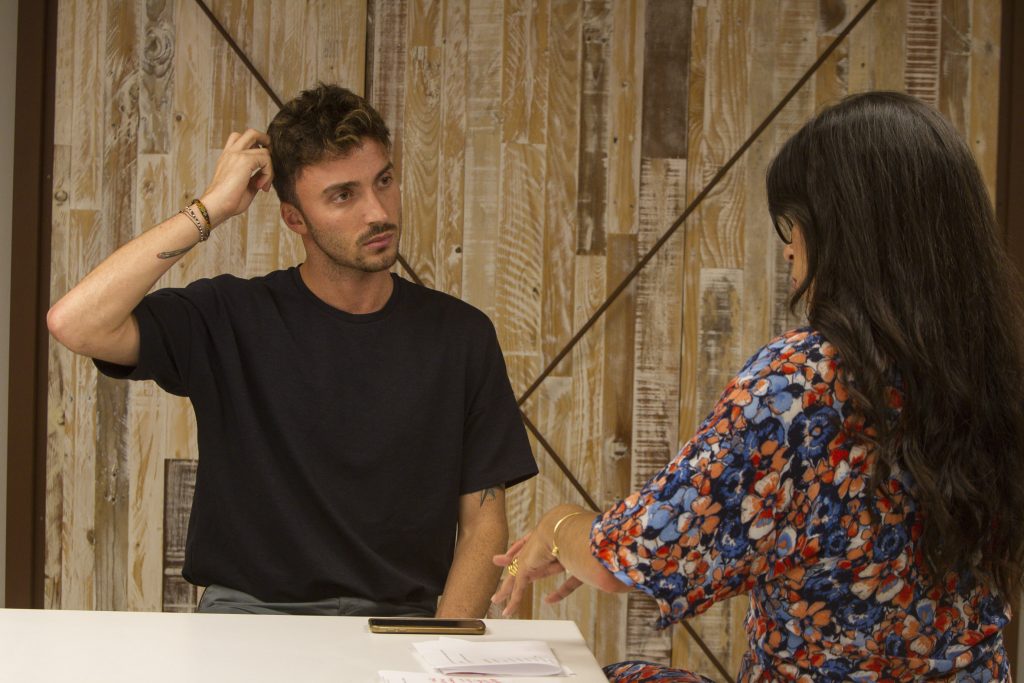
Questionnaire Gratacós
An essential garment… For a girl, a Vneck
A fetish fabric… Something that is shiny and conjures up the night
A colour you could not live without.. Black and red
A designer you admire… Tom Ford. I find him good in design and also at selling
An infallible style rule… A masculine-feminine mix
Your preferred space in Barcelona… I know so many different places that right now I cannot answer
A piece of advice for those starting out… Focus on what you want to do
Your leitmotif… Slowly but surely
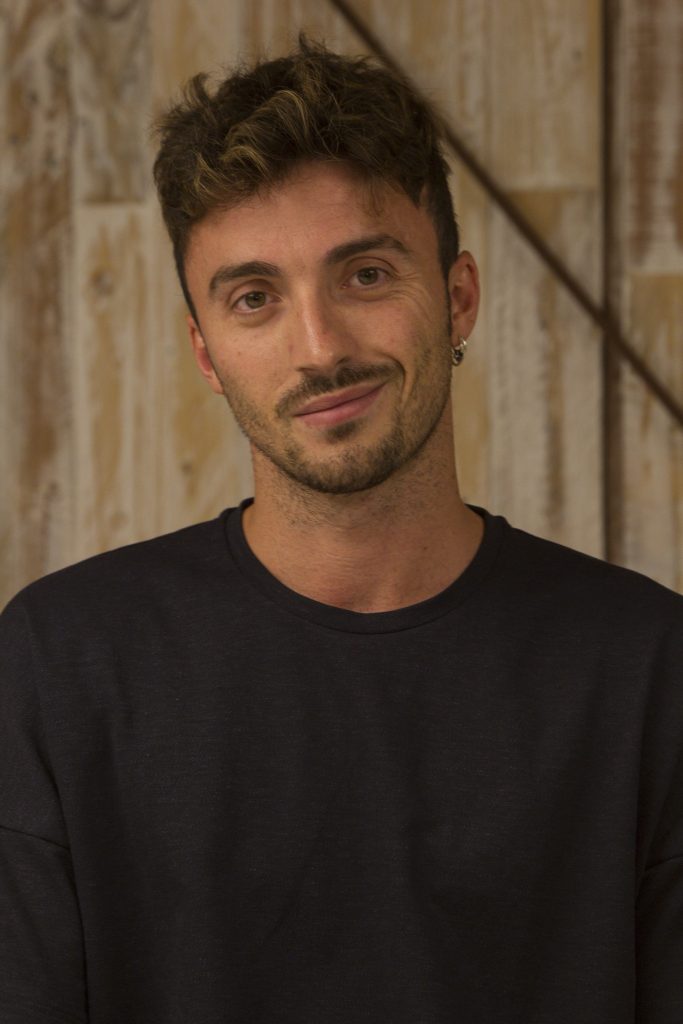
One to one with… Santos Costura

He has been in the sector for more than two decades, but he maintains the same passion as the day he begun. Santos López is the designer for Santocostura. Fom his workshop in Barcelona, he directs an artisan bridal brand with made to measure garments using quality fabrics and unique embroidery. His collections know no trends or fads and maintain a sophisticated timelessness with perfectly cut silhouettes. The Santoscostura dresses have appeared in a number of magazines and have been centre of attention on the red carpet. Nevertheless Santos López knows that being in the spotlight is one thing, but to get to the top, one must work very hard.
You define yourself as an artisan, rather than a designer.…
The value of our brand comes down to making artisan dresses with unique details that can only be done by working with one garment at a time. I like to preserve the traditional way of working with my hands, because handicraft is something that is coming to an end in Alta Costura.
Why?
At University, they forget to teach the most essential part of a business and I am not referring to the designer, who I do not deny is the soul, but they do not show the work of those who sew. They do not show the students how to sew and this is a skill that is disappearing. There is a general belief that it is a devalued job that does not require training, but this is not the case and the truth is we are losing workforce. When the seamstresses no longer exist, Alta Costura will disappear because this art that can not be exported to China nor India.
Despite this, we are going back to our traditional ways, or at least we are more conscientious …
Here is the inconsistency. Consumers value handicraft and customisation, but we are missing artisans to carry out this type of work.
«Consumers value handicraft but we are missing artisans»

Did you inherit your passion for sewing?
Yes, but not in a professional way. I studied Fine Arts because there were no specific university degrees for fashion. I later did various pattern and garment making courses and I learnt by myself. I never doubted this was meant for me.
Do you have any childhood memories?
I remember when my grandmother and I sewed laces together.
What was the first thing you sewed?
A bridal dress for one of my sisters dolls. I think it was a Nancy doll.
What did you learn in your first job?
That you need to work hard. The catwalks and the attention from the media are secondary,. You concentrate on designing and producing. It takes a lot of hours and a lot of effort.
What appealed to you about the bridal sector?
When I was 12, I read a book on the history of fashion and I recall being fascinated by it, especially two pages that talked about brides. When I finally decided to launch the Brand, I wanted to do something very artisinal. In the bridal sector there is always a lot more margin for handicraft and on top of that you are offering a daydream.
«In bridal, aswell as offering handicraft, you are offering a daydream»

What creative process do you follow in Santos Costura?
We work in two different ways. Firstly, we decide on a leitmotif and as from there we work on the collection with previously used fabrics that we join together with other embroidery that we make ourselves. The structured way would be think of the idea, draw the design, the patterns and prototypes. Secondly, we talk to the customer and gather up her ideas and tastes and we modify the garment in the collection until it meets her expectations.
What is the Santos Costura bride looking for?
They are looking for exclusivity and something that reflects their personality. It is true that our collection has a specific style to it but we adapt to what the customer wants so that that the bride does not feel like she is wearing fancy dress. The dress has to be in line with her style.
…And more so in the bridal sector where more than dresses, it is emotions that are sold.
Exactly! That is what we sell. Our work process with the customer is always very close and even though it is my team that starts dealing with the customer, I am always present at some time. I like to meet the brides and attend to them personally. I also like to be there in the dress fitting because it is important that they feel comfortable and I check that nothing has been missed.
What are the trends for 2017?
In the last few years we have gone from vintage to boho-chic gypsy style. This has completely changed now. At least with the brides I deal with. Now we find ourselves with a much more sophisticated bride, that does not want such a big dress, that likes transparencies to insinuate but now to show, with much more elaborated details like gemstones on the dress. These brides want a long sleeved dress, a closed neck and a large opening at the back. There is also a tendency to go back to the basics with a closed plain crepe dress. In general, there is retraint in manners and a sophistication in the small details.
«In general, there is restraint in manners and a sophistication in the small details.»

What are you goals for next year?
The brand is growing alot and I am thinking of things that I did not contemplate when I launched the company. People ask me for dresses from all over the world and my goal is to maintain demand without missing the little details. It is true that in exterior sales points we cannot offer customisation of the dress. We are currently thinking of designing a small collection so that brides that live abroad can have a bit of scope to modify the dress.
The Gratacós questionnaire…
An essential garment…. Some stilettos
A fetiche fabric… Lace
A colour you could not live without… Black
A designer you admire… The maestro Balenciaga and Josep Font de Delpozo
An infallible style rule… Dont look like you’re wearing fancy dress, be true to yourself
Your favourite place in Barcelona… The port
A piece of advise for designers starting out… Be prepared to work hard and never lose your passion
Your vital slogan… Above all honesty

